Meet the Giant Pacific Octopus today (you can also call it the North Pacific giant octopus) – one of the largest species of octopus in the world, known for its massive size and intelligence. Found in the North Pacific Ocean, these creatures can grow up to 16 feet in length and weigh up to 600 pounds.
With their ability to change color, texture, and shape, the Giant Pacific Octopus is a master of disguise and can easily blend into their surroundings. They are known to be highly intelligent, using tools, solving puzzles, and even escaping from aquarium tanks.
Do you think the Giant Pacific Octopus is the most intelligent creature in the world? Find out how they have been manipulating and deceiving humans for decades and more. So, let’s go behind the scenes of this impressive creature and uncover the fun facts about this massive sea creature.
About Giant Pacific Octopus – A Quick Biology
The Giant Pacific Octopus is an important species in the marine ecosystem and plays a crucial role in the balance of the ocean’s food chain. Let’s go through the quick biology of this beastly creature.
| Parameters | Details |
| Scientific Name | Enteroctopus dofleini |
| Kingdom | Animalia |
| Family | Enter Octopodidae |
| Genus | Enteroctopus |
| Phylum | Mollusca |
| Class | Cephalopoda |
| Order | Octopoda |
| Species | E. dofleini (formerly Octopus apollyon) |
| Habitat | Coastal waters to 330 ft (100 m) |
| Life Span | 4-5 years |
| Diet | clams, cockles, crabs, abalone, scallops, fish, fish eggs, and even other octopuses |
| Geography | Pacific Ocean (ranging south from southern Baja California and north to Alaska), west to the Aleutian Islands, and then south again to Japan |
| Weight & Length | 16 ft (5 m) in length, 110 lb (50 kg) weight |
Giant Pacific Octopus Encyclopedia: Top Facts
The encyclopedia of giant pacific octopuses is rich in fascinating facts, images, and information on this fantastic sea creature. Take a look below for more of these awesome facts about the Giant Pacific Octopus.
1. Etymology
Wow, it’s really interesting to learn about the etymology of the Giant Pacific Octopus! Did you know that its scientific name, Octopus dofleini, was named after the German researcher Franz Theodor Doflein?
That’s quite an honor! In 1998, Eric Hochberg changed the name to Enteroctopus. It’s fascinating to see how species are named and reclassified over time based on new research and discoveries. (Source)
2. Appearance
The National Geographic organization’s authors have defined the appearance in the following words:
“The giant Pacific octopus boasts an imposing, round head and is typically colored in a striking reddish-brown hue.” These creatures are truly a sight to behold and a fascinating part of the underwater world.
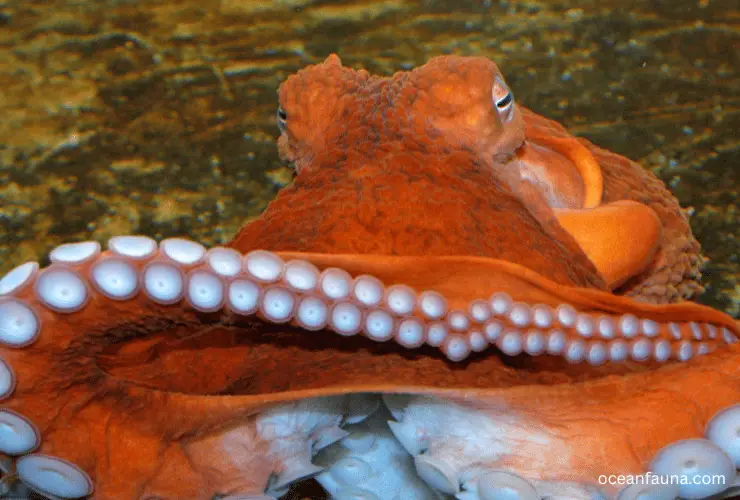
The giant Pacific octopus stands out not only for its size as the largest among octopuses but also for its signature reddish-pink hue. This coloring is due to its special pigment cells, known as chromatophores, which are situated just under its skin and enable it to effortlessly camouflage in its rocky or coral-rich surroundings.
As a mollusk, it is noteworthy that the octopus’ shell can be found in its head in the form of two small plates, while the rest of its body is soft and pliable. Due to their lack of an external shell, octopuses such as the giant Pacific octopus rely on their exceptional camouflage abilities to remain protected.” (Source)
Georgia Aquarium organization’s writers have further added:
“The size of a giant pacific octopus can vary based on the temperature of the water it inhabits.” For example, they tend to be smaller when they live in warmer waters and larger in colder waters such as the North Pacific.
“This creature is equipped with eight arms that extend from its body, each of which has two rows of suction cups, with the potential to have as many as 250 suction cups on a single arm.” (Source)
These unique physical features make the giant Pacific octopus an impressive and intriguing part of the underwater world.
3. Location
As documented by Wikipedia, the giant Pacific octopus has a wide range, inhabiting the following locations:
- North Pacific coastal areas of Mexico (Baja California)
- United States (including California, Oregon, Washington, and Alaska)
- Canada (British Columbia)
- Russia
- Eastern China
- Japan
- South Korea
This versatile sea creature can be found in its natural habitat from the intertidal zone to a depth of 2,000 meters (6,600 feet), thriving in cold and oxygen-rich waters.
4. Behavior
MarineBio organization’s researchers have explained the feeding behavior (ecology) of the giant pacific octopus in the words given below:
“Giant Pacific octopuses employ three distinct methods to access their hard-shelled prey. They may try to rip it apart, use their sharp beak to break it open or resort to drilling. When the first two methods prove ineffective, the octopus will begin to drill into the shell by softening it with secretions from the salivary papilla.
The softened material is then removed using the radula to create a small opening. Through this opening, the octopus secretes a toxin that paralyzes the prey and begins to dissolve its connective tissue. The final step is to tear the prey apart and consume it.” (Source)
5. Range and Habitat of Giant Pacific octopus
Georgia Aquarium organization’s authors have discussed the habitat and range of the giant pacific octopus in the following words:
“The giant Pacific octopus can be found along the Pacific coastline stretching from Southern California to Alaska and even as far as Japan. These creatures are known to thrive in a wide range of habitats, from shallow tidal pools to ocean depths reaching as low as 4,920 feet (1500 m).
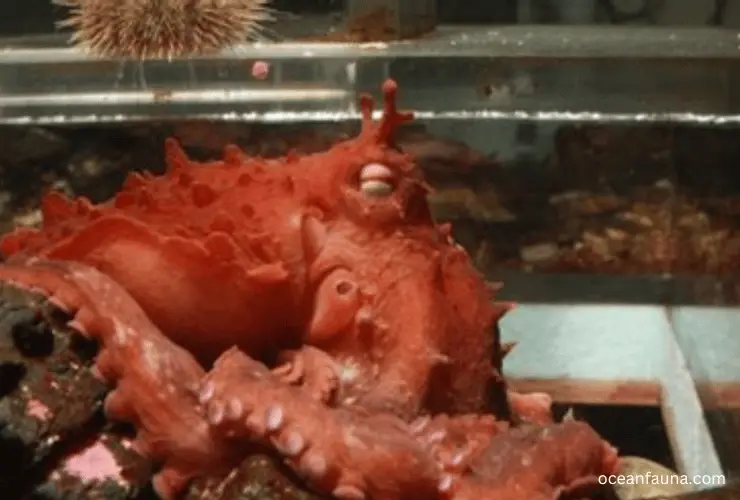
However, they tend to be most abundant in shallow waters that are no deeper than 16 feet (5 m). This adaptable species is a fascinating part of the rich and diverse underwater world.” (Source)
6. Diet or Feeding Habits
The Giant Pacific Octopus, or E. dofleini, is a versatile predator that feeds on a wide range of seafood. Its menu includes shrimp, crabs, scallops, abalone, cockles, snails, clams, lobsters, fish, squid, and even other octopuses. To catch its prey, Enteroctopus dofleini uses its powerful suckers to grasp its food and then bites into it using its tough beak made of chitin.
In captivity, it has been observed preying on spiny dogfish, which can grow up to 1.2 m (4 ft) in length. In the wild, giant Pacific octopus middens have been found containing carcasses of spiny dogfish, providing strong evidence that these octopuses are capable of preying on small sharks.
Wikipedia organization’s research has given the following creepy fact about the Giant Pacific Octopus:
“A 2012 incident involving an amateur photographer (Ginger Morneau) who captured a wild giant Pacific octopus attacking and drowning a seagull shows that this species will consume any available food source within its size range, including birds.” (Source)
7. Reproduction System
The Giant Pacific Octopus is capable of laying a substantial number of eggs, with a range from 120,000 to 400,000. These eggs are covered in a protective layer known as chorion and are attached to a hard surface by the female.
The female takes sole responsibility for caring for the eggs and remains close to them, continually blowing water over them and grooming them to eliminate any algae or other growths. During this time, the female forgoes food, leading to her eventual death by starvation after approximately 6 months.
The hatchlings, which are about the size of a grain of rice, face many challenges in their early stages of life and only a small number survive to adulthood. Despite their tiny size, they grow quickly, increasing by 0.9% per day, using most of their consumed energy for growth, respiration, physical activity, and reproduction.
To reproduce, the male Giant Pacific Octopus deposits a spermatophore, measuring more than 1 meter, into the female’s mantle using his specialized arm. The female stores the sperm in her spermatheca until she is ready to fertilize her eggs.
In one instance, a female at the Seattle Aquarium was observed to keep a spermatophore for seven months before laying fertilized eggs. Female giant Pacific octopuses are distinctive in that they are semelparous, which means they only engage in mating once in their lifetime, unlike males. (Source)
8. Cardiovascular and nervous system
The giant Pacific octopus possesses three hearts, each pumping blood through its closed circulatory system. The blood flows through veins, arteries, and capillaries. The first two hearts direct blood to the gills, while the third heart supplies blood to the rest of the body. Hemocyanin, an oxygen-transporting molecule, is present in its blood.
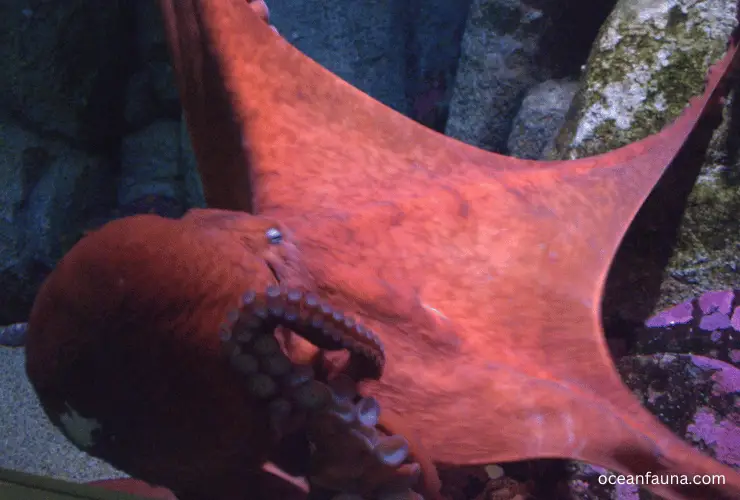
The octopus is a highly intelligent creature with a complex nervous system. It lacks defensive adaptations and instead relies on its brain to survive. These creatures have been extensively studied for their intelligence, making them a fascinating species to learn about.
9. Intelligence
Octopuses are acknowledged as the most intelligent invertebrates, with Giant Pacific octopuses frequently displayed in aquariums for their size and intriguing anatomy. Let’s see the following to get how intelligent these are:
- These creatures have demonstrated their capability to identify humans they often encounter. Their responses include actions such as propelling water, altering body texture, and other movements that are shown consistently to specific individuals.
- Additionally, octopuses have the proficiency to complete simple challenges, unscrew childproof bottles, and utilize tools. Their brain comprises intricately folded lobes, visual and tactile memory centers, and approximately 300 million neurons.
- These creatures have caused chaos in laboratories and aquariums by opening tank valves and disassembling costly equipment.
- Some researchers claim that octopuses possess the capacity for motor play and have unique personalities.
What’s more interesting? The giant Pacific octopus boasts exceptional eyesight and an incredibly sensitive sense of taste, which it detects through its suction cups.
10. Conservation Status
Unfortunately, Giant Pacific Octopuses are not yet protected by the Convention on International Trade in Endangered Species of Wild Fauna and Flora or evaluated on the IUCN Red List. This species of octopus has yet to be assessed by the Monterey Bay Aquarium Seafood Watch, although other octopus species have been listed.
The challenge of determining the abundance of these creatures is due to a lack of assessment, mislabeling, and the elusive nature of these solitary animals. Scientists have had to rely on the number of octopuses caught to estimate their population, but it can be difficult to locate these creatures.
In Puget Sound, the Washington Fish and Wildlife Commission took action to safeguard the harvest of Giant Pacific octopuses at seven designated sites following a public outcry over a legal harvest. Fortunately, the octopus populations in Puget Sound are not viewed as being in danger. (Source)
What Is the Size Of A Giant Pacific Octopus?
According to Wikipedia organization, E. dofleini, or Giant Pacific Octopus is the largest species of octopus and is known for its large size. Read on to know about some fun facts related to its size. (Source)
- Adults usually weigh around 15 kg (33 lb) with an arm span of up to 4.3 m (14 ft)
- The largest individuals have been measured at 50 kg (110 lb) and have a radial span of 6 m (20 ft)
- The largest suckers on a giant Pacific octopus are about 6.4 cm (2.5 in) and can support 16 kg (35 lb) each
- Seven-arm octopus (Haliphron atlanticus) is the alternative contender for the largest species of octopus
- Report of E. dofleini up to 272 kg (600 lb) in weight with a 9-meter (30-foot) arm span
- Guinness World Records lists the biggest as 136 kg (300 lb) with an arm span of 9.8 m (32 ft)
- A UN catalog of octopuses sizes E. dofleini at 180 kg (400 lb) with an arm length of 3 m (9.8 ft)
Are Giant Pacific Octopuses Venomous?
Yes, giant pacific octopuses are venomous. Let’s see what the researchers of Ocean Conservancy have said about its venom.
“It may come as a surprise, but all octopuses and cuttlefish have venomous bites, not just the notoriously dangerous species like the blue-ringed octopus. These creatures use their sharp beaks to inject their venom into their prey.
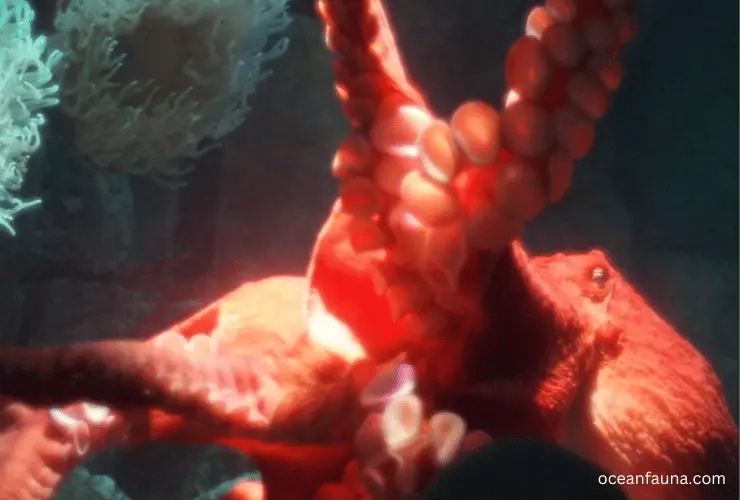
While the venom of some species can be dangerous to humans, it is important to remember that these creatures are simply trying to survive in their underwater environment and that venom is a natural defense mechanism.” (Source)
Scientists have discovered high levels of heavy metals and PCBs in the tissues and digestive glands of giant Pacific octopuses, which is believed to come from their primary food source, the red rock crab (Cancer productus). These crabs hide in contaminated sediments and consume prey that resides nearby.
The impact of these toxins on the octopuses is yet to be determined, but other animals that have been exposed to similar toxins have shown signs of liver damage, changes in their immune systems, and severe cases, death. Further research is needed to understand the full extent of these toxins on the octopuses and the underwater ecosystem in which they live.
What Adaptations Do the Giant Pacific Octopus Have?
The giant Pacific octopus is truly a master of disguise, much like a chameleon. These creatures can effortlessly change their appearance to blend in with the surrounding environment, mimicking the patterns and textures of rocks and highly decorative coral. Their ability to do so is a testament to the intelligence and adaptability of these remarkable invertebrates.
Let’s take a look at some of the most intriguing adaptations of giant pacific octopuses given by bioweb.uwlax.edu. (source)
- Arms: The Pacific octopus boasts eight strong arms with a powerful blend of radial and longitudinal muscles, capable of resisting forces up to 400 times its weight. The absence of bones in its arms and entire body enables its limbs to be highly flexible, allowing the octopus to squeeze into tight spaces.
- Suckers: The suckers on the arms of a giant Pacific octopus play a critical role in their senses of touch and taste. With thousands of chemical receptors, the rims of the suckers are extremely sensitive to touch, allowing the blindfolded octopus to differentiate objects. The suckers also can grip onto prey or the surrounding environment through suction.
- Chromatophores: The Pacific octopus is known for its skill in camouflage. This ability is made possible by its chromatophores – pigment sacs that allow it to blend into its environment. Each chromatophore contains three pigments – yellow, red, and brown. The color of the octopus’s skin is controlled by tiny muscles.
- Mouth: The giant Pacific octopus has a specialized mouth structure for feeding. Its sharp beak, similar to a parrot’s, is used for biting and holding prey. The radula, a rough, tongue-like structure with teeth ribbons, helps the octopus scrape food. The salivary glands produce venom, which is used to paralyze and start digestion. The venom is delivered through the salivary papillae, ending in drill-shaped teeth for drilling into prey’s shells.
Hope you love reading these unique adaptations of a giant pacific octopus.
What Are the Predators of Giant Pacific Octopuses?
Humans, birds, eels, fish, and sharks are one of the biggest predators of giant pacific octopuses. The eggs of the Giant Pacific Octopus are often threatened by scavengers and other organisms, despite the presence of the female to protect them.
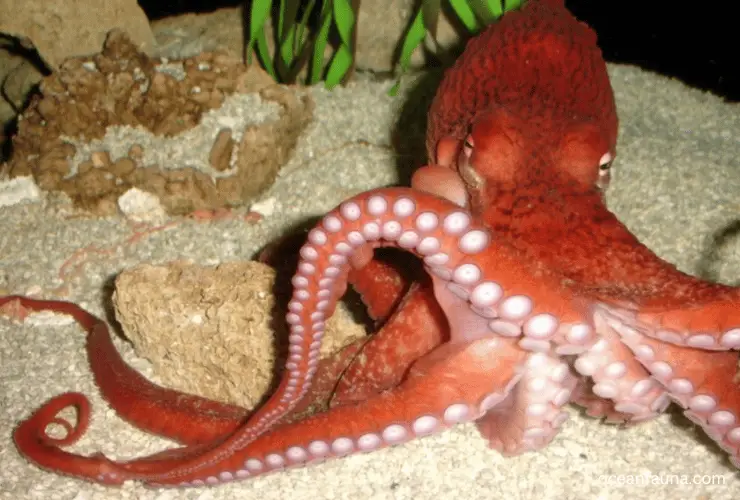
As paralarvae, they are vulnerable to predation by many zooplankton and filter feeders. This species plays an important role as a food source for several marine mammals, including harbor seals, sea otters, and sperm whales.
Pacific sleeper sharks are also known to prey on giant Pacific octopuses. In addition to being an important source of food for these animals, the giant Pacific octopus is also an important source of protein for human consumption, with over 3.3 million tonnes being commercially fished each year, worth approximately $6 billion. (Source)
Throughout history, humans have utilized a variety of methods to catch the octopus, including lures, spears, pot traps, nets, and even bare hands. Finally, the octopus is also host to the mesozoan parasite Dicyemodeca anthinocephalum, which inhabits its renal appendages.
The Most Versatile and Fascinating Facts About Giant Pacific Octopus
The Giant Pacific Octopus has a lot to discuss here. However, let’s deep dive into the sea of insights about the most versatile and fascinating facts about this sea lover given by the Oceana organization. (Source)
- Did you know that the Giant Pacific Octopus is a fascinating creature with many impressive abilities? For one, they can change their color in a split-second! This allows them to blend in with their surroundings and protect themselves from predators.
- Despite their massive size and intelligence, the Giant Pacific Octopus has a relatively short lifespan of 4-5 years.
- They reproduce just once in their lifetime and lay thousands of eggs, which they fiercely protect until they hatch.
- These incredible creatures can be found in the depths of the ocean, at depths of over 330 feet (100 meters). If you think that’s impressive, wait until you hear about their brooding process.
- Female Giant Pacific Octopuses are dedicated mothers and will remain with their eggs until they hatch, never leaving their side. Sadly, this also means that they eventually die from self-cannibalization shortly after the hatching process.
- Lastly, their arms are equipped with 2,140 to 2,240 suction cups that give them a strong grip and an acute sense of taste and smell. With these remarkable traits, it’s no wonder why the Giant Pacific Octopus is such a remarkable species.
Thus, the giant Pacific octopus is a remarkable and unique sea creature with many fascinating abilities and characteristics. From its ability to rapidly change color to its powerful grip, this animal truly showcases the diversity and complexity of the ocean’s inhabitants.
FAQs
Are giant Pacific octopuses friendly?
The Giant Pacific Octopus has a bite that is not only painful but also delivers venom, although it is not deadly. Despite this, they are typically known to be bashful and friendly to humans and do not often use their dangerous bite.
Is a giant Pacific octopus poisonous?
Yes, the giant pacific octopus is poisonous. The venom produced by the Giant Pacific Octopus can pose a threat to both humans and marine creatures. Though not lethal to humans, a bite from its sharp beak can cause a painful wound and slow down the healing process. The possibility of bacterial infection also remains a concern.
How big can a giant Pacific octopus get?
The giant Pacific octopus is a formidable creature in terms of size. Fully mature, they can reach over 50 pounds in weight. The largest recorded octopus was a staggering 200 pounds and had an impressive span of 20 feet.
Does a giant pacific octopus eat sharks?
The giant Pacific octopus is an opportunistic eater and may consume sharks. However, their preferred prey includes clams, cockles, crabs, abalone, scallops, fish, fish eggs, and other octopuses.
Conclusion
The Giant Pacific Octopus is a fascinating and unique species that plays a crucial role in the marine ecosystem. With its massive size, ability to blend into its surroundings, and high intelligence, this octopus is a force to be reckoned with. With its limited lifespan of 4-5 years, the Giant Pacific Octopus is an important species that should be protected and preserved for future generations to admire and study.

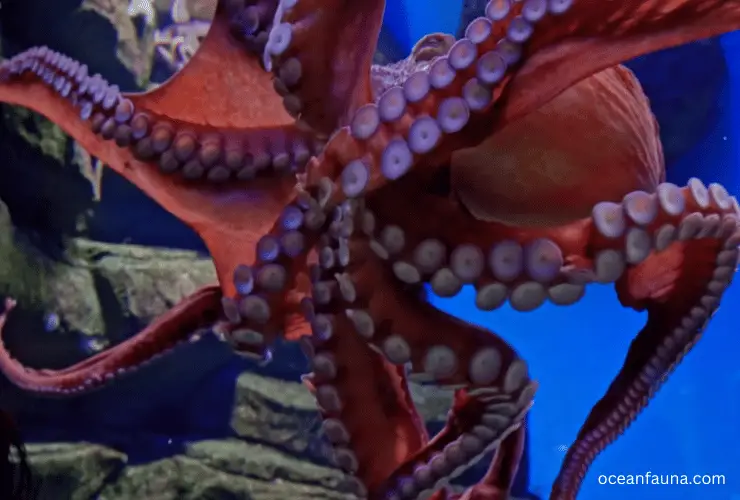
1 thought on “Giant Pacific Octopus: Habitat, Description & Facts”